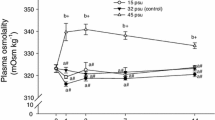Abstract
In order to study the interaction of the extracellular and intracellular osmoregulatory systems of the bivalve Rangia cuneata, we have measured blood osmotic and ionic concentrations together with intracellular free amino acid concentrations and total tissue water under identical salinity conditions. Like freshwater bivalves, the blood of R. cuneata is maintained hyperosmotic (50 mOsm) to the environment in salinities below 110 mosm by the regulation of Na+, Cl-, K+ and Ca2+ concentrations. On the other hand in company with marine bivalves, R. cuneata also regulates intracellular free amino acids (FAA) as a mechanism to control cellular volume during osmotic stress over the entire non-lethal salinity range (3 to 620 mOsm). Alanine is the predominant intracellular osmotic effector. Thus, by utilizing the osmoregulatory mechanisms of both marine and freshwater bivalves, R. cuneata is able to tolerate salinities ranging from freshwater to 25 ppt and to traverse the faunal salinity boundary, known as the horohalinicum (5 to 8 ppt), controlling cell volume throughout.
Similar content being viewed by others
Literature Cited
Allen, K.: The effect of salinity on the amino acid and concentration in Rangia cuneata (Pelecypoda). Biol. Bull. 121, 419–424 (1961)
Baginski, R. M. and S. K. Pierce: Anaerobiosis: A possible source of osmotic solute for high-salinity acclimation in marine molluscs. J. exp. Biol. 62, 589–598 (1975)
Bedford, W. B. and J. W. Anderson: The physiological response of the estuarine clam Rangia cuneata (Gray) to salinity I: Osmoregulation. Physiol. Zool. 45, 255–260 (1972)
Castagna, M. and D. Chanley: Salinity tolerance of some marine bivalves from inshore and estuarine environments in Virginia waters on the western mid-Atlantic Coast. Malacologia. 12(1), 47–96 (1973)
Deaton, L. J. and M. J. Greenberg: Ionic regulation in two species of bivalve. Am. Zool. 17, 902 (Abstract) (1977)
Dietz, T. H. and W. D. Branton: Ionic regulation in the freshwater mussel Ligumia subrosterata (Say). J. comp. Physiol. 104, 19–26 (1975)
Fyhn, H. J. and J. D. Costlow: Anaerobic sampling of body fluids in bivalve molluscs. Comp. Biochem. Physiol. 53A, 19–30 (1975)
Fyhn, H. J.: A note on the hyperosmotic regulation in the brackish-water clam Rangia cuneata. J. comp. Physiol. 107, 159–167 (1976)
Gainey, L. F. and M. J. Greenberg: Physiological basis of the species abundance-salinity relationship in molluscs: A speculation. Mar. Biol. 40, 41–49 (1977)
Khlebovich, V. V.: Aspects of animal evolution related to critical salinity and internal stake. Mar. Biol. 2, 338–45 (1969)
Kinne, O.: Salinity. Animals-invertebrates. In: Marine ecology Vol. 1: Environmental factors, part 2, (edited by Kinne, O.). pp. 821–995. London: Wiley-Interscience 1971
Otto, J. and S. K. Pierce: An interaction of extra- and intracellular osmoregulatory mechanisms in the bivalve mollusc Rangia cuneata. Mar. Biol. 61, 197–198 (1981)
Pierce, S. K., Jr.: The water balance of Modiolus (Mollusca: Bivalvia: Mytilidae): Osmotic concentrations in changing salinities. Comp. Biochem. Physiol. 36, 521–533 (1970)
Pierce, S. K., Jr.: Volume regulation and valve movements in marine mussels. Comp. Biochem. Physiol. 39A, 103–117 (1971a)
Pierce, S. K., Jr.: A source of solute for volume regulation in marine mussels. Comp. Biochem. Physiol. 38A, 619–635 (1971b)
Pierce, S. K., Jr. and M. J. Greenberg: The initiation and control of free amino acid regulation of cell volume in salinity stressed marine bivalves. J. exp. Biol. 59, 435–440 (1973)
Potts, W. T. W. and G. Parry: Osmotic and ionic regulation in animals. Pergamon Press, New York 1963
Robertson, J. D.: Osmotic and ionic regulation. In: Physiology of mollusca (edited by Wilbur, K. M. and Yonge, C. M.) Vol. 1, pp. 283–311. New York: Academic Press 1964
Saintsing, D. G. and D. W. Towle: Na++K+ ATPase in the osmoregulating clam Rangia cuneata. J. exp. Zool. 206, 435–442 (1979)
Watts, J. A. and S. K. Pierce: A correlation between the activity of divalent cation activated adenosine triphosphatase in the cell membrane and low salinity tolerance of the ribbed mussel, Modiolus demissus demissus. J. exp. Zool. 204, 49–56 (1978b)
Author information
Authors and Affiliations
Additional information
Communicated by I. Morris, West Boothbay Harbor
Please address requests for reprints to Dr. S. K. Pierce
Rights and permissions
About this article
Cite this article
Otto, J., Pierce, S.K. Water balance systems of Rangia cuneata: ionic and amino acid regulation in changing salinities. Mar. Biol. 61, 185–192 (1981). https://doi.org/10.1007/BF00386658
Accepted:
Issue Date:
DOI: https://doi.org/10.1007/BF00386658




